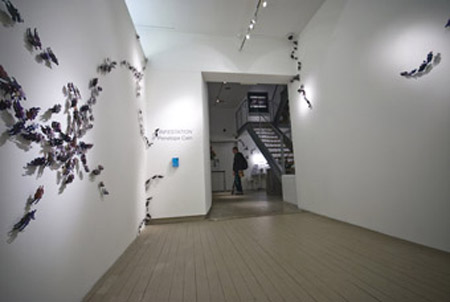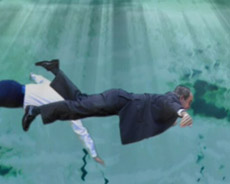infestation
 |
Penelope Cain |
urban entomologyIt would not be the first time a gallery has had an embarrassingly bad infestation, but fortunately for the ACP this one has stopped short of gnawed corners and unsightly droppings. The pests, which have crawled up the walls of the foyer and are collecting menacingly in groups, appear from a distance the size of overfed cockroaches, but on closer inspection are the latest results of Penelope Cain’s obsessive investigation into the urban condition. Cain disarmingly flips our perception of these creatures to which an initial response is almost certainly tinged with fear and disgust. They are in fact the respectable figures of smart-suited businessmen, albeit shrunk to tiny proportions and crawling on their hands and knees. With the apparently frenzied installation carefully constructed to mimic the group dynamics of insects, like ants or cockroaches, we are forced to recognise a similarity in the desperate behaviour of urban life: the commute to and from work, our incessant need to get somewhere fast or to seek something more. Yet Cain asks us to consider human behaviour with the same distance and rational perspective we apply to the investigation of other species. The suited men are pinned to the wall through their torsos, killed and preserved as in entomological collections—their layers of acetate reminiscent of delicately spread butterfly wings. Like the artist, the viewer becomes a social scientist, observing and reflecting on the human condition, charged with drawing scientific conclusions. Infestation is accompanied by Sink or Swim, which is shown in the ACP video lounge and at night is projected onto the front window of the gallery for passersby to see. In striking contrast to Infestation, here businessmen swim through translucent, turquoise waters, creating beautiful, almost idyllic imagery. But as they continuously swim past on loop, the action itself becomes inescapable, as does the sense of imminent threat. Propelled by the fear of stopping, perhaps, or the consequences of falling out of the rat race, the urban dweller is driven not by ambition but survival. Suited or not, and whatever our jobs, we are all contenders in the rat race and if the comparison is uncomfortable, perhaps in one way or another Cain has got us pinned. Josephine Skinner |
 |
Penelope CainPenelope Cain is a Sydney-based interdisciplinary artist, working across drawing, installation and video media. Since graduating from ANU in 2001 Cain’s work has gained significant recognition; she won the Churchie Emerging Art Prize in 2007, was the recipient of an Asialink residency to Taipei in 2008 and an Australia Council Residency in Rome 2008-2009. I had the opportunity to discuss with Cain the principles underpinning her work and how her recent residencies have influenced her practice. InterviewWhat informs your visual language, in particular the recurring motif of business workers portraying animal behaviour? My interest in animal behaviour comes from having a background in science and I tend to draw on this when working through ideas and concepts. I frequently use this visual language as a technique to separate out strands of human-ness and create a sense of 'the other': the human-animal. It is also useful shorthand for a set of behaviours or a sociological position. Principles of evolution, Darwinian psychology and the history of scientific investigation all inform my work, especially the exuberant amateur botanists and biologists of the 18th and 19th centuries. Infestation developed initially during an Asialink residency in Taiwan, how did your experience there influence your work? Taiwan has an interesting history, at the centre of which seems to be a trade-based power shift cycling between China, Japan and USA. I was interested in the flow of trade, money and power around and through this small pragmatic country. The work started as musings on the ubiquitousness of business-suit wearing men and women in Asia. There is of course a gender subtext in all of this... Women are far less represented in your work than men, or at least the iconic image of 'businessman'; can you elaborate on that subtext? It seems to me that there are still more men than women out there in senior levels of the workplace and government, the magnet of power attracts men in suits. In my pseudo-scientific alternative hypotheses there are herds, flocks and schools of almost identical suit-wearing men, but there is usually a smaller proportion of women in suits, never leading and always towards the middle of the pack. Infestation is currently taking over the foyer of the Australian Centre for Photography, how does the work relate to photography? I am happy to site Infestation within the ACP and see it as a photo-based work. The insect-like figures are essentially low-fi 3-D objects made from a 2-D digital printing technique using images from digital video stills. I like the notion that they encapsulate the fluid evolution of photography as a technologically-based medium. The installation of this work is integral to its disarming effect, tapping into common fears relating to pests and vermin. How is audience experience important to your work? For me one of the joys of installation art is expanding the number of levels at which the audience can engage with my work. I hope that the massing of vermin-like forms does evoke a mixture of interest and humour with a frisson of insect-based discomfort. The video work Sink or Swim appears inviting yet the title tells another story. I feel that the underwater world is a variant take on 'the other'—the viscosity, the light, the changed gravity, the inversion of known concepts of safety and danger are all intriguing to me. It is a space for hypothetical alternatives to the here-and-now and I wanted to have a sort of controlled collision between these two worlds. The rear-projection of Sink or Swim onto the front window at the ACP inserts these large-scale, swimming business figures into the evening commuter space of Oxford Street. I especially enjoy working with large format projections in urban spaces for this effect of colliding two worlds within the one location. You have recently returned from an Australia Council Residency in Italy, did you find it a productive experience? Rome was a fabulous place for research. I have this ongoing obsession with cities and urban areas and Rome has been an evolving urban space for thousands of years, with the marks of its evolution exposed across its landscape. The continuity of the city across time and the way the contemporary inhabitants make room for those past iterations is astounding. I studied the city at a macro level, working with different renderings of the sewage systems, street patterns and parking stations. Lastly, what do you have planned for the future? I am exhibiting in the 2009 Albury Art Prize and am also working towards a show at MOP in September. In terms of research I am trying to tease out an indistinct link between the patterns of pedestrians as they negotiate the street level spaces in Sydney and the flow of material along electricity grids, data grids and sewerage pipes—the transient patterns of city use. Penelope Cain, Infestation, Australian Centre for Photography, Sydney, June 12-July 11, 2009 Images courtesy of the artist and the Australian Centre for Photography |








 back
back